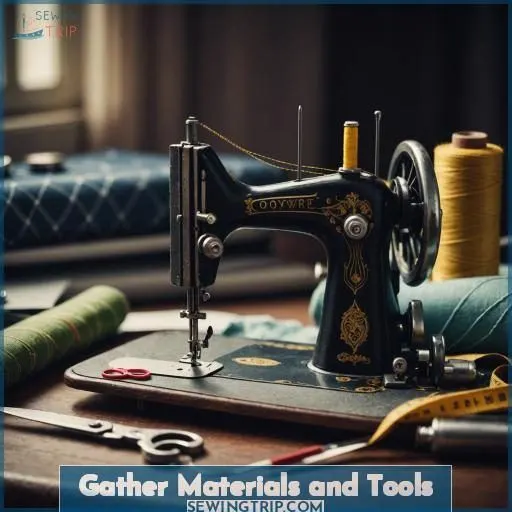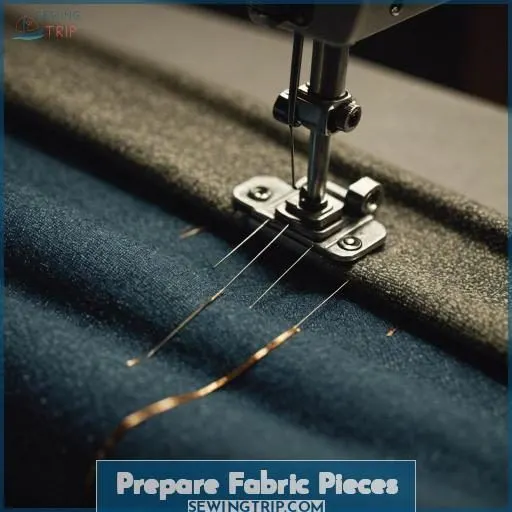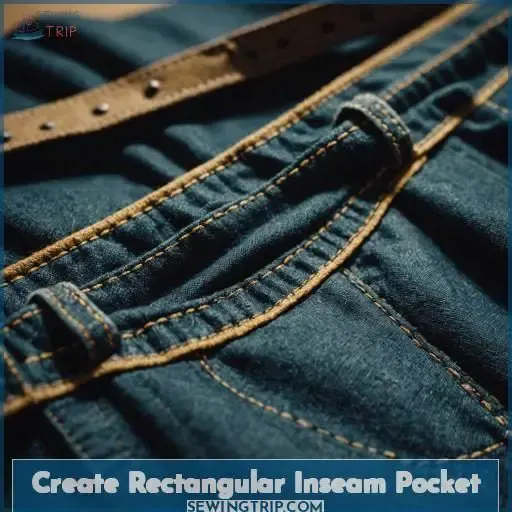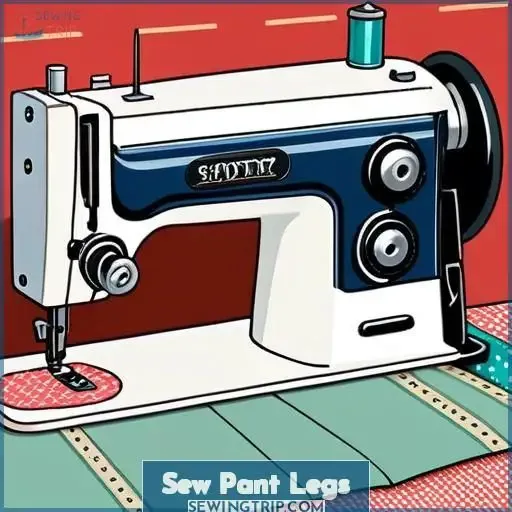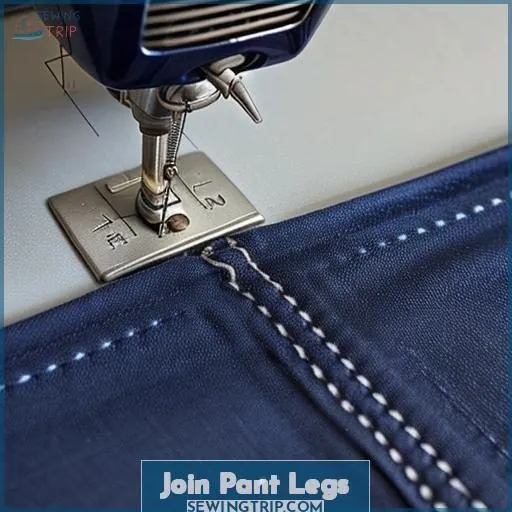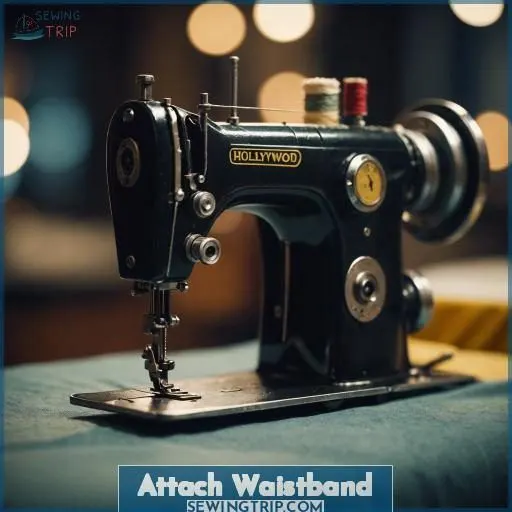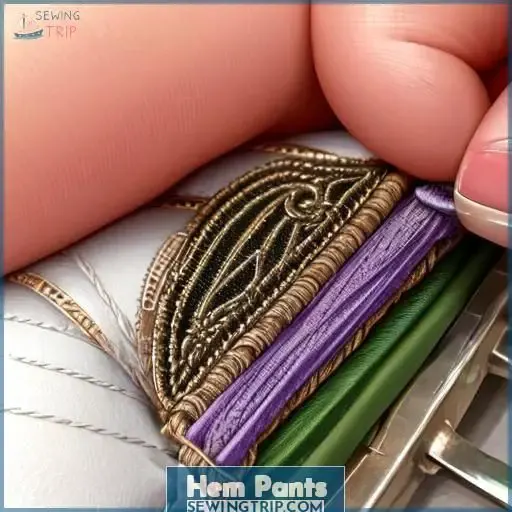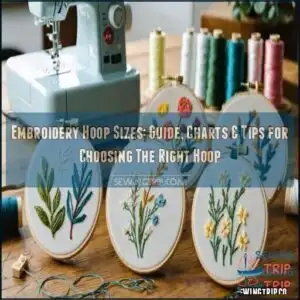This site is supported by our readers. We may earn a commission, at no cost to you, if you purchase through links.
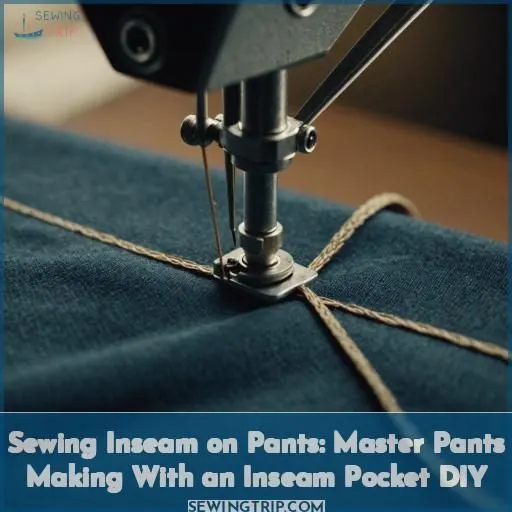 To create an inseam pocket on pants, place the pocket piece on the front pant leg, aligning the right sides.
To create an inseam pocket on pants, place the pocket piece on the front pant leg, aligning the right sides.
Sew along the straight edge, then fold the legs to create the pocket opening.
Trim the seam allowances at the opening and reinforce by sewing above and below the trimmed areas. This forms the inseam pocket.
Proceed to assemble the pant legs by sewing the outer and inner seams, finishing raw edges, and connecting the legs at the crotch seam.
With the pocket secured, you can proceed to attach the waistband and hem the pants to finish the project.
This essential step enables the full potential of customized pants construction.
Table Of Contents
Key Takeaways
- Proper fabric preparation, including tracing pattern pieces with a seam allowance and cutting the front, back, and pocket pieces, is crucial for successful pants construction.
- Creating an inseam pocket involves sewing the pocket piece to the front pant leg, folding the legs to form the pocket opening, trimming the seam allowances, and reinforcing the opening for a secure and functional pocket.
- Sewing the pant legs includes stitching the outside and inside seams, finishing raw edges, and joining the legs at the crotch seam, ensuring proper alignment and a professional finish.
- Attaching the waistband, hemming the pants, and applying finishing touches like pressing and trimming excess threads completes the pants-making process, resulting in a stylish and comfortable pair of custom-fitted trousers.
Gather Materials and Tools
You’ll need a lightweight poly/rayon fabric (around 2 yards), matching thread, 2-inch wide elastic, sewing pins, a sewing machine, scissors, an iron, and an ironing board. Make sure you have all the necessary materials and tools collected before starting the pants-making process.
Lightweight Poly/rayon Fabric
Lightweight poly/rayon fabric is ideal for pants due to its soft drape and breathability. Choose a color that complements your style.
Matching Thread
Choose thread weight, color, and type wisely. Adjust tension for smooth stitching. Store thread properly. Follow pocket tutorial for inseam pants sewing.
| Thread Weight | Thread Color | Thread Type |
|---|---|---|
| Lightweight | Match fabric | All-purpose |
| Medium | Contrast | Polyester |
| Heavy | Blend | Cotton |
2. inch Wide Elastic
Grab 2-inch wide elastic for a snug, comfortable waistband. Position and insert elastic with even tension for a perfect fit.
Sewing Pins
You’ll also need sewing pins to:
- Guarantee pinning accuracy.
- Plan pin placement.
- Match pin types/sizes.
Sewing Machine
You’ll need a sturdy sewing machine for smooth stitching. Consider an adjustable design.
Scissors
Grab sharp scissors; you’ll need cutting precision for fabric accuracy.
Iron
You’ll need an iron to press seams and shapes fabric pieces correctly.
Ironing Board
You’ll also need an ironing board to smooth out fabric pieces and pant sections. Here are four tips:
- Adjust height
- Use proper cover
- Make sure stable footing
- Check for heat-proof surface
An ironing board allows precise pressing and proper fabric care during pants construction. With the right ironing techniques and heat settings for your fabric type, you’ll achieve professional-looking results. Proper fabric preparation is key to successful pant making.
Prepare Fabric Pieces
To prepare the fabric pieces, start by tracing the pants pattern pieces onto the fabric while they’re inside out. Cut around the tracing, adding a 1/2 inch seam allowance, and you’ll need two front pieces, two back pieces, and two pocket pieces, all cut with a slight forward dip in the front pant legs.
Trace Pants Inside Out and Add 1/2 Seam Allowance
You’ll trace the pants pattern onto fabric, inside out. Add a 1/2 seam allowance on all edges for proper seaming. For the front, trace a slight forward dip to allow ease over your knees – this provides comfort and a professional look. Precisely trace the shape, ensuring the seam allowance remains consistent. This guarantees your pants fit impeccably.
Cut 2 Front Pieces, 2 Back Pieces, and 2 Pocket Pieces
With your fabric laid flat, use your traced pattern to cut 2 front pieces, 2 back pieces, and 2 pocket pieces from the lightweight poly/rayon, leaving 1/2 inch seam allowance. Pay close attention to pocket placement, ensuring they line up with the front pant legs. Double-check your cutting – accurate fabric shapes are key for proper seam alignment and a professional finish.
Create Rectangular Inseam Pocket
It’s time to add an inseam pocket – the perfect spot to stash your phone or keys.
First, position the pocket piece on the front pant leg, right sides together, and sew along the straight edge.
Flip it open and do the same for the back leg.
Now fold the legs so the pocket forms – you’re a master tailor!
Clip those seam allowances at the opening for a crisp finish.
Reinforce by sewing above and below the clipped areas – no fraying pockets on your watch.
The pocket size is key – not too big to bunch but roomy enough to be functional.
As for placement, higher on the hip is trendy but lower provides easier access.
A poly-rayon blend offers the perfect balance of structure and stretch for your pocket fabric.
With a reinforced zig-zag stitch, that pocket will be secure yet seamless.
Just a few pro touches make all the difference.
Sew Pant Legs
Begin by sewing the outside and inside seams of each pant leg, making sure to finish the raw edges neatly to prevent fraying. This will create two separate pant leg tubes ready for joining.
Sew Outside and Inside Seams of Each Pant Leg
Next up, you’ll sew the outside and inside seams of each pant leg:
- With right sides together, pin the curved edges, matching the seam allowances.
- Thread your machine and adjust the stitch length to your desired setting.
- Slowly guide the curved fabric edges under the presser foot as you sew.
Take your time aligning those curved edges perfectly. Once sewn, you’ll have a complete pant leg – well on your way to mastering pants construction!
Finish Raw Edges
You’ll need pressing equipment like an iron and board to neatly finish the raw seam allowances. Consider using an overlock stitch on a serger machine for professional-looking edges that won’t fray. Alternatively, simply turn under the seam allowances and press for a crisp, polished look on your finished product. Taking this extra step elevates the whole garment.
Join Pant Legs
With both pant legs now sewn, carefully insert one pant leg inside the other, making sure the curved inseam edges align. Pin the curved edges together, precisely matching the seams, and sew along the pinned seam to join the two legs together.
Insert One Pant Leg Into the Other
Next, insert one pant leg into the other, right sides together.
Make sure the pocket placements line up – this inseam construction is essential for a polished finish.
For fabrics susceptible to fraying, finish raw edges before joining.
If using a slippery poly blend, use short basting stitches when matching the curved seams.
Proper seam alignment creates a smooth, professional appearance.
Match Curved Edges and Sew
Positioning the curved edges appropriately ensures a flattering fit.
Align the front and back curved edges, pinning for precision.
Precise placement of the inseam pocket is crucial here.
Ponder using a lightweight, breathable fabric such as cotton lawn for the pocket.
Strengthen the curved seam with a series of topstitching or bar tacks.
Alternatively, finish with a flat-felled seam for enhanced durability.
Attach Waistband
For the waistband, fold your 2-inch wide elastic in half lengthwise with the wrong sides together, then sew the short ends to form a loop. With right sides together, pin the raw edge of the waistband to the raw edge of the pant top, stretching the elastic to fit smoothly as you sew.
Fold Waistband in Half Lengthwise, Wrong Sides Together
With the pant legs joined, fold the waistband fabric lengthwise, wrong sides together. Align and adjust its length to fit your waist neatly, with seams facing outwards for a neat look.
Sew Short Ends of Waistband
With the waistband folded, sew the short ends together to create a circle. This waistband construction is essential for proper inseam pocket placement and fit adjustments. Then:
- Finish all raw edges neatly
- Check for sizing before topstitching
- Topstitch if satisfied with waistband’s fit
- Consider using contrasting thread color
Attach Waistband to Pants, Right Sides Together
With the waistband seamed, place it on the pant’s right side, matching the width. Pin every few inches, adjusting for comfort and your fabric’s stretch. Sew waistband securely, using a seam finish that complements the fabric type and desired stretchiness.
Fold Waistband to Inside and Topstitch
With the waistband attached, fold it inwards, aligning the raw waistband edge with the pants. Topstitch around the waistband’s width using a 1/4 seam allowance, securing it to the pants’ body.
Hem Pants
To hem your pants, first fold the fabric to your desired length, pressing it flat and pinning it in place. Next, topstitch along the fold to secure the hem in place, ensuring an even and professional finish.
Fold Hem to Desired Length
Next, fold the hem to your preferred length—whether ankle-length, cropped, or c■. You’ve got options for your hem types: machine-stitched, blind-stitched, or even a simple serged edge. Consider the hem allowances too, as they impact the hem finish and overall drape.
Press and Pin in Place
Once the hem reaches your desired length, press it firmly. Use pins to carefully hold it in place, ensuring:
- Precise pocket placement avoids bunching
- Consistent seam allowance is maintained
- Fabric choice allows proper drape
- Pocket size is comfortable yet functional
- Strategic reinforcement prevents tearing
Topstitch Hem in Place
Topstitch hem in place using your machine’s topstitch setting. Adjust thread tension and stitch length for a smooth finish. Stitch slowly, guiding fabric gently. Backstitch at start and end. Trim loose threads. Press hem to set stitches. Voila! Your pants are ready to wear with style and comfort.
Finish and Press
With your pants now fully assembled, it’s time to put the finishing touches on your creation. First, give your pants a thorough inspection, ensuring no loose threads remain. Carefully trim any excess fabric from the seams, being mindful not to cut too close to the stitching. Next, press your pants with a hot iron, focusing on the seams and creases to create a crisp, professional look. As you press, consider these customization options:
- Experiment with different inseam finishes, such as a Hong Kong seam or a flat-felled seam, for added durability and style.
- Adjust pocket placement to suit your preferences, ensuring they’re positioned comfortably and securely.
- Choose fabrics that not only look great but also provide the desired level of comfort and durability for your specific needs.
- Reinforce critical seams, like the inseam and crotch area, for added strength and longevity.
With your pants pressed and ready, you can confidently strut your stuff, knowing you’ve created a pair of custom-fitted trousers that are both stylish and comfortable. Congratulations on mastering the art of sewing inseam on pants!
Frequently Asked Questions (FAQs)
How do I adjust the fit of the pants?
To adjust fit: Take in/let out side seams for waist; adjust rise length at crotch seam; add/remove length at hems.
What if my fabric is too thick for the machine?
You’re a clever one, tackling thick fabrics. Try a denim or leather needle, adjust tension/pressure foot, and go slowly. Or, outsmart it – hand-baste first, then machine stitch.
Can I use a serger instead of finishing seams?
You’ll never have to fret about raveling seams ever again! Utilizing a serger bestows a proficient, overlocked edge that thwarts fraying and enhances durability. Simply verify that your serger is correctly threaded and tensions are calibrated for the best possible results on any fabric weight.
How do I sew a curved inseam neatly?
To sew curved inseams neatly, pin and baste the edges first. As you approach the curve, take tiny stitches, guiding the fabric smoothly. Use a tailor’s ham or curved surface to press the seam open once stitched.
What if my pocket fabric doesnt match the pants?
You’ve got options – accent the pockets with contrasting fabric or opt for matching thread that blends seamlessly. Remember, confident crafters embrace creative touches that reflect their unique style.
Conclusion
Envisioning the sleek, customized pants draped gracefully over your frame, you can take immense pride in the intricate sewing inseam you have mastered.
This fundamental technique, coupled with your newfound skills in creating an inseam pocket, waistband attachment, and professional hemming, empowers you to craft garments that exude refinement and personal flair.
Embrace your accomplishment and let your sartorial prowess shine.

